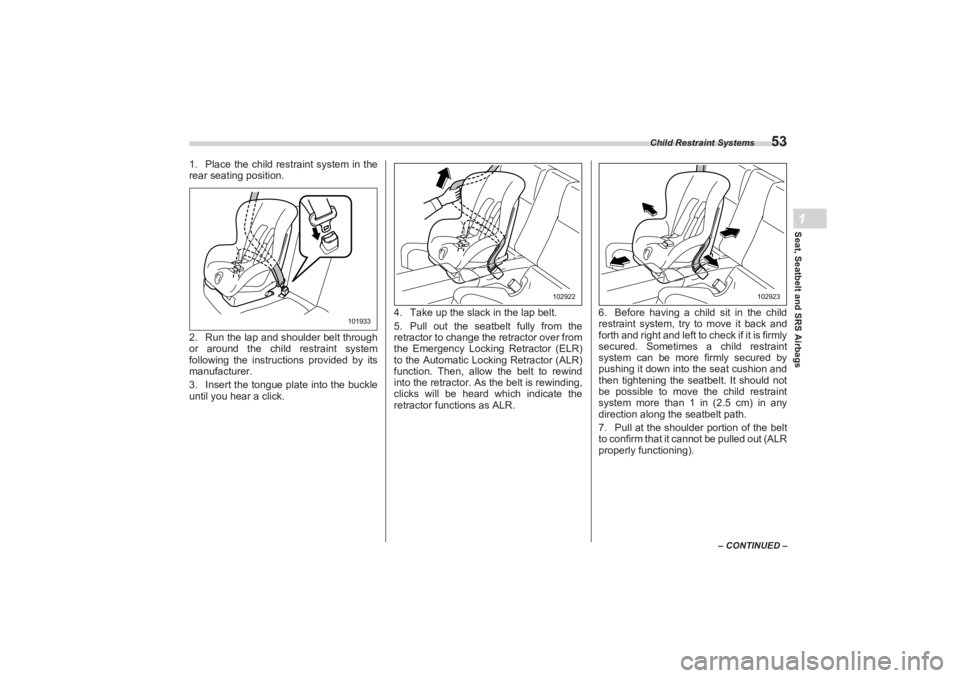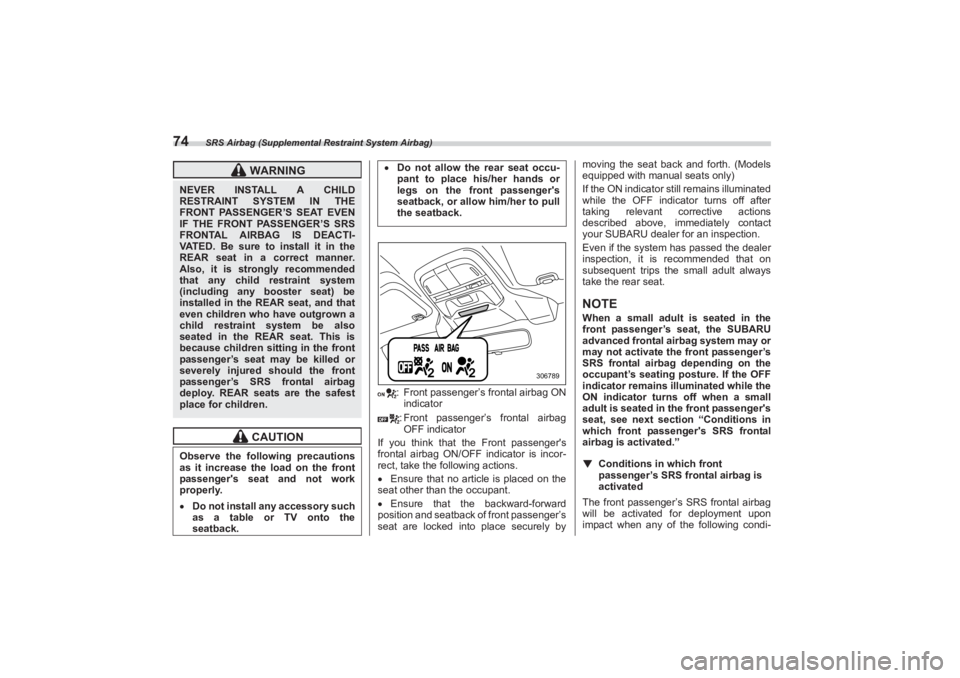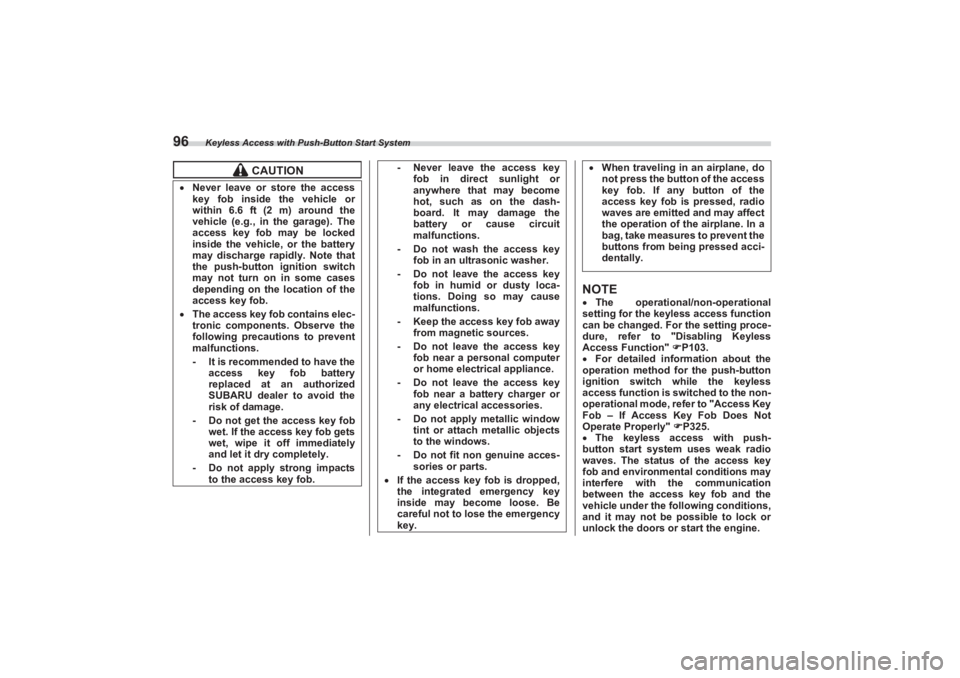2023 SUBARU BRZ lock
[x] Cancel search: lockPage 59 of 432

Child Restraint Systems
53
Seat, Seatbelt and SRS Airbags1
– CONTINUED –
1. Place the child restraint system in the
rear seating position.
2. Run the lap and shoulder belt through
or around the child restraint system
following the instructions provided by its
manufacturer.
3. Insert the tongue plate into the buckle
until you hear a click. 4. Take up the slack in the lap belt.
5. Pull out the seatbelt fully from the
retractor to change the retractor over from
the Emergency Locking Retractor (ELR)
to the Automatic Locking Retractor (ALR)
function. Then, allow the belt to rewind
into the retractor. As the belt is rewinding,
clicks will be heard which indicate the
retractor functions as ALR. 6. Before having a child sit in the child
restraint system, try to move it back and
forth and right and left to check if it is firmly
secured. Sometimes a child restraint
system can be more firmly secured by
pushing it down into the seat cushion and
then tightening the seatbelt. It should not
be possible to move the child restraint
system more than 1 in (2.5 cm) in any
direction along the seatbelt path.
7. Pull at the shoulder portion of the belt
to confirm that it cannot be pulled out (ALR
properly functioning).
101933
102922
102923
BRZ_U.book 53 ページ 2022年3月29日 火曜日 午後3時59分
Page 63 of 432

Child Restraint Systems
57
Seat, Seatbelt and SRS Airbags1
– CONTINUED –
in the above illustration. For details, refer
to "Top Tether Anchorages" P59.
▽ To install a child restraint
system using lower and tether
anchorages
1. Move the seatback back and forth to
confirm that it is securely locked into
place.
Check that the red colored
unlocking marker on the lock release
button is not visible. For details, refer
to "Folding Down the Rear Seatback"
P37. 2. You will find “ ” marks at the bottoms
of the rear seatback. These marks indi-
cate the positions of the lower anchorages
(bars).
Each lower anchorage is located behind
the cover of seatback bottom. Peel off the anchorage cover completely
from the selected side of the rear
seatback to expose the anchorages (bars)
to be used for installation of the child
restraint system.
If it is hard to install the child restraint
system because the anchorage cover
returns to the original position, press the
anchorage cover to the seat cushion until
it is flat.
WARNING
Before installing a child restraint
system, be sure to confirm that the
seatback is securely locked into
place. Otherwise, in an accident,
serious injury or death could result.
CAUTION
When you install a child restraint
system, follow the manufacturer’s
instructions supplied with it. After
installing the child restraint system,
check to ensure that it is held
securely in position. If it is not held
tight and secure, the danger of your
child suffering personal injury in
the event of an accident may be
increased.
102678
102760
BRZ_U.book 57 ページ 2022年3月29日 火曜日 午後3時59分
Page 77 of 432

SRS Airbag (Supplemental Restraint System Airbag)
71
Seat, Seatbelt and SRS Airbags1
– CONTINUED –
▼Front passenger’s SRS frontal
airbagThe front passenger’s SRS frontal airbag
uses a dual stage inflator. The inflator
operates in different ways depending on
the severity of impact.1) Occupant detection sensorsThe occupant detection sensors are
installed between the seat and seat rails,
and monitor the physique and posture of
the front passenger. Using this informa-
tion, the occupant detection system deter-
mines whether the front passenger’s SRS
frontal airbag should be deployed or not.
The occupant detect ion system may not
inflate the front passenger’s SRS frontal
airbag even when the driver’s SRS frontal
airbag deploys. This is normal. In this
case, although the front passenger’s SRS frontal airbag does not operate, the front
passenger’s seatbelt pretensioner oper-
ates with the driver’s seatbelt
pretensioner. For details about the
seatbelt pretensioner, refer to "Seatbelt
Pretensioners" P44.
102171
1
CAUTION
Observe the following precautions.
Failure to do so may prevent the
SUBARU advanced frontal airbag
system from functioning correctly
or cause the system to fail. Do not apply any strong impact to
the front passenger’s seat such
as by kicking. Do not let rear passengers rest
their feet between the front
seatback and seat cushion. Do not remove or disassemble
the front passenger’s seat. Do not install any accessory
(such as an audio amplifier) other
than a genuine SUBARU acces-
sory under the front passenger’s
seat. Do not place anything (shoes,
umbrella, etc.) under the front
passenger’s seat.
Do not place any objects (books,
etc.) around the front
passenger’s seat. Do not use the front passenger’s
seat with the head restraint
removed. Do not leave any articles on the
front passenger’s seat or the
seatbelt tongue and buckle
engaged when you leave your
vehicle. Do not put sharp object(s) on the
seat or pierce the seat uphol-
stery. Do not place a magnet near the
seatbelt buckle and the seatbelt
retractor. Do not use front seats with their
backward-forward position and
seatback not being locked into
place securely. If any of them are
not locked securely, adjust them
again. For adjusting procedure,
refer to "Manual Seat" P33
(models equipped with manual
seats only).
BRZ_U.book 71 ページ 2022年3月29日 火曜日 午後3時59分
Page 80 of 432

SRS Airbag (Supplemental Restraint System Airbag)
74
: Front passenger’s frontal airbag ON
indicator
: Front passenger’s frontal airbag
OFF indicator
If you think that the Front passenger's
frontal airbag ON/OFF indicator is incor-
rect, take the following actions.
Ensure that no article is placed on the
seat other than the occupant.
Ensure that the backward-forward
position and seatback of front passenger’s
seat are locked into place securely by moving the seat back and forth. (Models
equipped with manual seats only)
If the ON indicator still remains illuminated
while the OFF indicator turns off after
taking relevant corrective actions
described above, immediately contact
your SUBARU dealer for an inspection.
Even if the system has passed the dealer
inspection, it is recommended that on
subsequent trips the small adult always
take the rear seat.
NOTEWhen a small adult is seated in the
front passenger’s seat, the SUBARU
advanced frontal airbag system may or
may not activate th e front passenger’s
SRS frontal airbag depending on the
occupant’s seating posture. If the OFF
indicator remains illuminated while the
ON indicator turns off when a small
adult is seated in the front passenger's
seat, see next section “Conditions in
which front passenger's SRS frontal
airbag is activated.”▼ Conditions in which front
passenger’s SRS frontal airbag is
activatedThe front passenger’s SRS frontal airbag
will be activated for deployment upon
impact when any of the following condi-
WARNING
NEVER INSTALL A CHILD
RESTRAINT SYSTEM IN THE
FRONT PASSENGER’S SEAT EVEN
IF THE FRONT PASSENGER’S SRS
FRONTAL AIRBAG IS DEACTI-
VATED. Be sure to install it in the
REAR seat in a correct manner.
Also, it is strongly recommended
that any child restraint system
(including any booster seat) be
installed in the REAR seat, and that
even children who have outgrown a
child restraint system be also
seated in the REAR seat. This is
because children sitting in the front
passenger’s seat may be killed or
severely injured should the front
passenger’s SRS frontal airbag
deploy. REAR seats are the safest
place for children.
CAUTION
Observe the following precautions
as it increase the load on the front
passenger's seat and not work
properly. Do not install any accessory such
as a table or TV onto the
seatback.
Do not allow the rear seat occu-
pant to place his/her hands or
legs on the front passenger's
seatback, or allow him/her to pull
the seatback.
306789
BRZ_U.book 74 ページ 2022年3月29日 火曜日 午後3時59分
Page 99 of 432

Keys and Doors2
Keys and Doors
2-1. Keyless Access with Push-Button Start
System .................................................................94
Safety Precautions ..... .......................................... ..........94
Locking and Unlocking with “Keyless Access”
Entry Function ..............................................................97
Unlock Using PIN Code Access ..................................100
Power Saving Function ................................................102
Power Saving Function of Access Key Fob...............103
Disabling Keyless Access Function ...........................103
Selecting Audible Signal Operation (If Equipped).....105
Selecting Hazard Warning Flasher Operation ...........106
Warning Chimes and Warning Indicator ....................106
When Access Key Fob Does Not Operate
Properly.......................................................................106
Replacing Battery of Access Key Fob ........................106
Replacing Access Key Fob..........................................106
Certification for Keyless Access with Push-Button
Start System ...............................................................106
2-2. Immobilizer ..........................................................108
Security Indicator Light ...............................................108
Key Replacement..........................................................108
Certification for Immobilizer System ..........................108
2-3. Remote Keyless Entry System ..........................109
Locking the Doors ........................................................110
Unlocking the Doors ....................................................110
Opening the Trunk Lid .................................................110 Setting Audible Signal Operation (If Equipped)........ 110
Selecting Hazard Warning Flasher Operation........... 110
Vehicle Finder Function .............................................. 110
Sounding a Panic Alarm ............................................. 110
Replacing the Battery .................................................. 111
Replacing Lost Transmitters ...................................... 111
2-4. Door Locks ..........................................................111
Locking and Unlocking from the Outside ................. 111
Locking and Unlocking from the Inside .................... 112
Key Lock-In Prevention Function............................... 113
Battery Drainage Prevention Function ...................... 113
2-5. Alarm System ......................................................114
Alarm System Operation ............................................. 114
Arming the System ...................................................... 114
Disarming the System ................................................. 115
Alarm System Setting.................................................. 115
If You Have Accidentally Triggered the Alarm
System........................................................................ 116
2-6. Windows ..............................................................116
Power Window Operation ........................................... 117
Initialization of Power Window ................................... 118
2-7. Trunk Lid ..............................................................119
To Open and Close the Trunk Lid from Outside ....... 120
To Open the Trunk Lid from Inside ............................ 121
Internal Trunk Lid Release Handle ............................. 121
BRZ_U.book 93 ページ 2022年3月29日 火曜日 午後3時59分
Page 100 of 432

Keyless Access with Push-Button Start System
942-1. Keyless Access with Push-Button Start SystemThe following access key fobs are
provided with the vehicle.1) Access key fob
2) Key number plateThe keyless access with push-button start
system allows you to perform the following
functions when you are carrying the
access key fob.
Locking and unlocking of the doors,
fuel filler lid
Opening the trunk
Starting and stopping the engine. For
detailed information, refer to "Starting and
Stopping Engine" P229.
Arming and disarming the alarm
system. For detailed in formation, refer to
"Alarm System" P114.
NOTE Locking and unlocking by the
remote keyless entry system can also
be controlled with the buttons on the
access key fob. For detailed informa-
tion, refer to "Remote Keyless Entry
System" P109.
Carefully store the key number plate
supplied with the access key fob. It is
necessary for vehicle repair and addi-
tional registration of access key fobs.
For details, refer to "Key Replacement"
P108.
An emergency key is attached to each
access key fob.
1) Release button
2) Emergency keyWhile pressing the release button of the
access key fob, take out the emergency
key.
The emergency key is used for locking
and unlocking the driver’s door.■ Safety Precautions
203629
11 2
WARNING
If you wear an implanted pacemaker
or an implanted defibrillator, stay at
least 8.7 in (22 cm) away from the
transmitting antennas installed on
the vehicle.
1
2
202500
BRZ_U.book 94 ページ 2022年3月29日 火曜日 午後3時59分
Page 102 of 432

Keyless Access with Push-Button Start System
96
NOTEThe operational/non-operational
setting for the keyless access function
can be changed. For the setting proce-
dure, refer to "Disabling Keyless
Access Function" P103.
For detailed info rmation about the
operation method fo r the push-button
ignition switch while the keyless
access function is switched to the non-
operational mode, refer to "Access Key
Fob – If Access Key Fob Does Not
Operate Properly" P325.
The keyless access with push-
button start system uses weak radio
waves. The status of the access key
fob and environmental conditions may
interfere with the communication
between the access key fob and the
vehicle under the following conditions,
and it may not be possible to lock or
unlock the doors or start the engine.
CAUTION
Never leave or store the access
key fob inside the vehicle or
within 6.6 ft (2 m) around the
vehicle (e.g., in the garage). The
access key fob may be locked
inside the vehicle, or the battery
may discharge rapidly. Note that
the push-button ignition switch
may not turn on in some cases
depending on the location of the
access key fob. The access key fob contains elec-
tronic components. Observe the
following precautions to prevent
malfunctions.
- It is recommended to have the
access key fob battery
replaced at an authorized
SUBARU dealer to avoid the
risk of damage.- Do not get the access key fob
wet. If the access key fob gets
wet, wipe it off immediately
and let it dry completely.- Do not apply strong impacts
to the access key fob.
- Never leave the access key
fob in direct sunlight or
anywhere that may become
hot, such as on the dash-
board. It may damage the
battery or cause circuit
malfunctions.- Do not wash the access key
fob in an ultrasonic washer.- Do not leave the access key
fob in humid or dusty loca-
tions. Doing so may cause
malfunctions.- Keep the access key fob away
from magnetic sources.- Do not leave the access key
fob near a personal computer
or home electrical appliance.- Do not leave the access key
fob near a battery charger or
any electrical accessories.- Do not apply metallic window
tint or attach metallic objects
to the windows.- Do not fit non genuine acces- sories or parts.
If the access key fob is dropped,
the integrated emergency key
inside may become loose. Be
careful not to lose the emergency
key.
When traveling in an airplane, do
not press the button of the access
key fob. If any button of the
access key fob is pressed, radio
waves are emitted and may affect
the operation of the airplane. In a
bag, take measures to prevent the
buttons from being pressed acci-
dentally.
BRZ_U.book 96 ページ 2022年3月29日 火曜日 午後3時59分
Page 103 of 432

Keyless Access with Push-Button Start System
97
Keys and Doors2
– CONTINUED –
- When operating near a facility
where strong radio waves are trans-
mitted, such as a broadcast station
and power transmission lines.
- When products that transmit
radio waves are used, such as an
access key fob or a remote trans-
mitter key of another vehicle.
- When carrying the access key
fob of your vehicle together with the
access key fob or the remote trans-
mitter of another vehicle.
- When the access key fob is
placed near wireless communica-
tion equipment such as a cell phone.
- When the access key fob is
placed near a metallic object.
- When metallic accessories are
attached to the access key fob.
- When carrying the access key
fob with an elec tronic appliance
such as a laptop computer.
- When the battery of the access
key fob is discharged.
The access key fob is always
communicating with the vehicle and is
continuously using the battery.
Although the life of the battery varies
depending on the operating condi-
tions, it is approximately 1 to 2 years. If
the battery becomes fully discharged,
replace it with a new one.
If an access key fob is lost, it is
recommended that all of the remaining
access key fobs be reregistered. For
reregistration of an access key fob,
contact a SUBARU dealer.
For a spare access key fob, contact
a SUBARU dealer.
Up to 7 access key fobs can be
registered for one vehicle.
Do not leave the access key fob in
the storage spaces inside the vehicle,
such as the door pocket, dashboard or
inside the corner of the trunk. Vibra-
tions may damage the access key fob
or turn on the switch, possibly
resulting in a lockout.
After the vehicle battery is
discharged or replaced, initialization of
the steering lock system may be
required to start the engine. In this
case, perform the following procedure
to initialize the steering lock. (1) Turn the push -button ignition
switch to the “OFF” position. For
details, refer to "Switching Power
Status" P125.
(2) Open and close the driver’s door.
(3) Wait for approximately 10
seconds.
When the steering is locked, the initial-
ization is completed.
Do not leave the access key fob in
the following places. - On the instrument panel
- On the floor
- Inside the glove box
- Inside the door trim pocket
- On the rear seat
- On the rear shelf
- Inside the trunk
If you do, the following situations
may occur. - The access key fob is mistakenly
locked inside the vehicle.
- A false warning issues although
no malfunction actually occurs.
- No warning issues even when a
malfunction occurs.
■ Locking and Unlocking with
“Keyless Access” Entry
FunctionWhen the access key fob is carried within
the operating range, the doors, the fuel
filler lid can be locked/unlocked just by
touching the door handle.NOTEThe vehicle can also be locked/
unlocked with the remote keyless
entry system. For details, refer to
"Remote Keyless Entry System"
P109.
BRZ_U.book 97 ページ 2022年3月29日 火曜日 午後3時59分